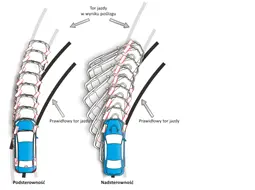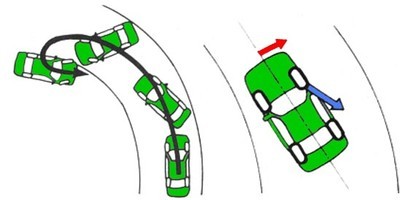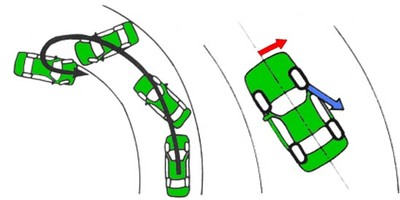
Oversteer and understeer
 These terms describe how a car behaves on the road. The vehicle may oversteer or understeer. Both of these phenomena will never occur at the same time.
These terms describe how a car behaves on the road. The vehicle may oversteer or understeer. Both of these phenomena will never occur at the same time.
Oversteer
This is the car's tendency to tighten the curve. The moment the car begins to turn left, the front of the car turns more than the rear. In other words, the rear end begins to overtake the front end of the car, causing the car to spin on its own axis and push the car into a ditch on the side of the road where the car is turning.
 | Left: Tendency to tighten the bend. On right: In the event of oversteer, the VSC brakes the outer front wheel. |
Understeer
It's the exact opposite of oversteer. An understeer car tends to widen the curve. In a turn, the car is raised to the outside of the road, which means that it reacts to the steering wheel with a delay.
 | Left: The tendency to widen the curve, to take the car out into the street. On right: In the event of understeer, it first "brakes" the inside rear wheel to bring the vehicle back to the rails, then the outside rear wheel to slow down. |
Danger
Neither is beneficial. However, you will have to learn how to respond to unusual vehicle behavior such as a corner tightening (understeer) or steering wheel drop (oversteer). Fortunately, under normal operating conditions, a car can only have one of these characteristics. So, if we get used to the behavior of our car, we will subconsciously correct its movement, without even realizing the delicate maneuver.
How to resist?
Automotive electronics have evolved so much that in modern cars, numerous sensors are able to determine whether the car is understeer or oversteer, and correct its trajectory.
In the event of oversteer, the system brakes the outer front wheel. So the car begins to turn on the outer arc.
If the vehicle is understeered and exits the corner, the system brakes the inside rear wheel. The vehicle then returns to the correct track and the braking system also acts on the outer rear wheel to reduce speed. Both of these tendencies are only dangerous when cornering at excessive speed. In normal driving, they should not be a problem for the driver.
» To the beginning of the article